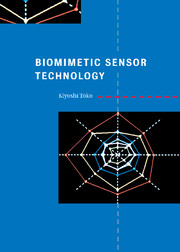4 - Biosensors
Published online by Cambridge University Press: 23 October 2009
Summary
Principle of biosensors
A biosensor is a kind of a chemical sensor that measures chemical substances by means of biomaterials and related materials (see Table 1.3). Biosensors can be classified by the biomaterial used into enzyme, microbial, immuno-, organelle and tissue sensors (Fig. 4.1).
A biosensor is, in principle, made by immobilizing these biomaterials and related materials to a sensing membrane and combining this with an electrochemical device. As shown in Fig. 4.2, it converts the concentration of chemical substances to be measured into light, sound and oxygen concentration by means of the biomaterial-immobilized membrane. It is possible to estimate the concentration of chemical substances by changing this quantity to an electric signal using an electrode and a thermistor. In all, a biosensor system consists of a receptor membrane where the reaction (or response) takes place, a transducer that transforms the concentration of chemical substances into an electric signal and recording equipment or computer. In an SPR (surface plasmon resonance) biosensor, the change of refractive index near the membrane surface caused by an antigen–antibody reaction is quantified by the resonance-angle change, which can be simply transformed to an electric signal using an electronic circuit.
We use an electrode as a transducer in most cases. The method to obtain electric signals is classified roughly into potentiometry and amperometry.
- Type
- Chapter
- Information
- Biomimetic Sensor Technology , pp. 77 - 91Publisher: Cambridge University PressPrint publication year: 2000



